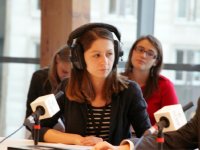To Teach Students First
Meet diverse learners’ needs through a range of classroom strategies that includes lecture, discussion, experiential learning, games, student presentations, technology integration, and free response writing.
Your content has been saved!
Go to My Saved Content.Several years ago when I was teaching AP European history, I struggled to meet the needs of the different learners in my class. I charged through the content as prescribed by the College Board and sought ways to differentiate learning and vary delivery through a few modes of instruction. It was not easy to do.
However, I had a breakthrough moment with one particular student who had been struggling to demonstrate mastery and understanding with traditional assessments like free response and document-based questions.
Historical Meets Hysterical
In a unit on late 19th-century nationalism, and at the suggestion of a student, we decided as a class to put on our version of The Colbert Report under the guise of different European countries going through nationalist development at that time. Students broke up into different country groups and planned their versions of The Colbert Report, incorporating appropriate and relevant content with interesting twists and segments akin to Colbert's flow and structure, which at that time was extremely popular with students.
The level of engagement was high, the desire for performance was evident, and collaboration was a necessity. Each group surged ahead with preparation and had loads of fun putting together their own version of the show.
The student that I mentioned above performed regularly in school drama productions and was a talented performer. He was passionate about production and had an uncanny ability to mimic TV personalities. Sure enough, when his time arrived with his group, he showed up to class dressed in full Stephen Colbert character. He took the stage, had memorized all of his lines, and nailed the delivery with polished dramatic style. He absolutely wowed his classmates, not only with his thespian skills, but also with his deep mastery of the content.
In a less traditional and more experiential format, he demonstrated mastery of content and concepts, and his peers loved his stellar performance. He felt a renewed sense of competence, and from that point forward, his in-class performance flourished on both traditional and nontraditional assessments.
I tell this story because I spent a lot of time figuring out how to reach this student, and I was only sorry that it took until the late 19th-century part of the course to come up with a different and more effective mode of instruction to help him feel successful.
Plan, Plan, Plan
From that point on, I vowed to incorporate at least one experiential learning exercise into each unit of study: debates, press conferences, mock murder mysteries, dinner parties, salons, general assembly meetings, or TV shows like The Colbert Report and Survivor.
I had learned that to meet the needs of diverse learners, it is critical to examine and be precise in our planning to ensure that we design instruction that will grab the attention and expertise of each student. For planning purposes, I developed a chart for the course and for each unit of study that hit on these (and more) elements:
- Lecture
- Discussion
- Experiential learning
- Games
- Student presentations
- Document analysis via paintings and primary sources
- Technology integration
- Free response writing
As I mapped each week of the course, I broke each day into different component parts, to make sure that I was diversifying delivery and keeping the approach fresh and engaging. Lectures never ran more than 12 minutes, class often started generatively with a painting of or excerpt from a primary source, and we often finished with the exit strategy of a quick game so that students left feeling energized and reflective. And, in this chart, I listed the students whose needs I felt I was best meeting with each learning activity.
Initially, this proved to be a time-consuming exercise, but as I became more proficient and efficient with organization and planning, I found that the exercise of charting everything actually saved me time and improved instruction for each student. I had listened more carefully to the needs of my students and shifted from teaching content to teaching students. And, not surprisingly, students retained the material at a far deeper and more meaningful level.
The student who performed that spot-on mimicry of Stephen Colbert taught me something valuable about engagement and lesson design. He learned differently than the majority of his peers.
And I had to adjust.
How do you see the difference between teaching students and teaching curriculum? What valuable lessons have you learned from your students? Please tell us about it below in the comments section.
